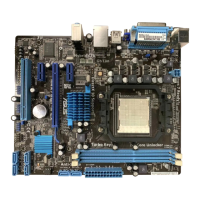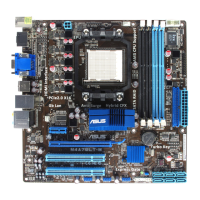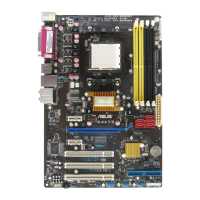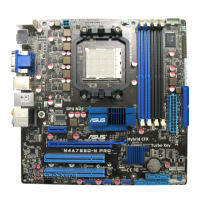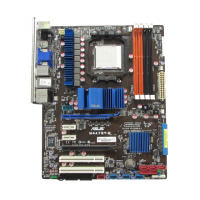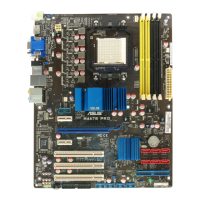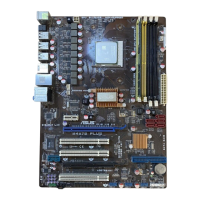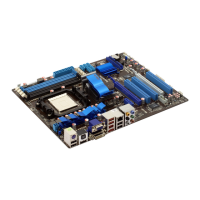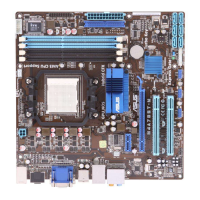Do you have a question about the Asus M4A78LT PLUS and is the answer not in the manual?
Instructions to prevent electric shock hazards and ensure safe handling of components.
Precautions for installing hardware, handling components, and system operation.
Details the structure and parts of the user guide.
Explains symbols and conventions used throughout the manual.
Lists resources for additional information and product updates.
Explains the use of bold text, italics, and key notations in the manual.
Precautions to take before installing components or changing settings.
General introduction to the motherboard's layout and components.
Diagram and labels of motherboard components and connectors.
Reference list of motherboard connectors, jumpers, slots, and LEDs.
Information about installing and configuring the CPU.
Step-by-step guide for installing the CPU into the socket.
Instructions for mounting the CPU heatsink and fan assembly.
Information about system memory installation and configuration.
Details on compatible memory sizes, speeds, and configurations.
Step-by-step guide for installing a memory module (DIMM).
Instructions for safely removing a memory module (DIMM).
Information on installing and using expansion cards in PCI and PCIe slots.
Step-by-step instructions for installing an expansion card.
How to configure installed expansion cards via software settings.
Details on PCI, PCI Express x1, and PCI Express x16 slots and their compatibility.
Information on jumpers for system configuration.
How to clear the CMOS settings using the CLRTC jumper.
Overview of motherboard connectors.
Description of ports located on the back panel of the motherboard.
Details on internal connectors for fans, audio, and power.
Guide for connecting ATX power supply to the motherboard.
Information on Serial ATA connectors for storage devices and RAID.
Connectors for adding front panel USB ports.
Information on supported operating systems and drivers.
Guidelines for installing OS and prerequisites for driver installation.
Details about the included support DVD and its contents.
Procedures for managing and updating the motherboard BIOS.
Utility for updating BIOS from within Windows.
Utility for updating BIOS directly from the BIOS interface.
Tool for recovering the BIOS from corruption.
Utility for updating BIOS in a DOS environment.
Overview of the BIOS setup interface and navigation.
Explains the layout and elements of the BIOS setup screen.
Explains menu items, submenus, fields, pop-ups, scroll bars, and help text within the BIOS.
Overview of the main BIOS settings screen.
How to set the system time in the BIOS.
How to set the system date in the BIOS.
Information and settings for SATA devices.
Configuration options for SATA storage devices.
Displays system specifications like BIOS, CPU, and memory.
Advanced system settings for CPU and devices.
Settings related to the CPU's performance and features.
Configuration options for the motherboard chipset and memory controller.
Settings for integrated motherboard devices like audio and LAN.
Settings for PCI/PnP device resource allocation.
Settings for USB functionality and ports.
Power management settings for the system.
Configures system suspend states.
Enables or disables ACPI 2.0 support.
Enables or disables ACPI APIC support.
Advanced Power Management settings.
Settings for monitoring hardware status like temperature and fan speed.
Configuration for Energy Using Products (EuP) requirements.
Settings for system boot order and options.
Sets the sequence for boot devices.
Various boot-related settings like quick boot and logo display.
Settings for system security, including passwords.
Access to special function utilities.
Utility for updating BIOS from the BIOS interface.
Utility for saving and loading BIOS settings profiles.
Options for saving or discarding BIOS changes and loading defaults.
Instructions to prevent electric shock hazards and ensure safe handling of components.
Precautions for installing hardware, handling components, and system operation.
Details the structure and parts of the user guide.
Explains symbols and conventions used throughout the manual.
Lists resources for additional information and product updates.
Explains the use of bold text, italics, and key notations in the manual.
Precautions to take before installing components or changing settings.
General introduction to the motherboard's layout and components.
Diagram and labels of motherboard components and connectors.
Reference list of motherboard connectors, jumpers, slots, and LEDs.
Information about installing and configuring the CPU.
Step-by-step guide for installing the CPU into the socket.
Instructions for mounting the CPU heatsink and fan assembly.
Information about system memory installation and configuration.
Details on compatible memory sizes, speeds, and configurations.
Step-by-step guide for installing a memory module (DIMM).
Instructions for safely removing a memory module (DIMM).
Information on installing and using expansion cards in PCI and PCIe slots.
Step-by-step instructions for installing an expansion card.
How to configure installed expansion cards via software settings.
Details on PCI, PCI Express x1, and PCI Express x16 slots and their compatibility.
Information on jumpers for system configuration.
How to clear the CMOS settings using the CLRTC jumper.
Overview of motherboard connectors.
Description of ports located on the back panel of the motherboard.
Details on internal connectors for fans, audio, and power.
Guide for connecting ATX power supply to the motherboard.
Information on Serial ATA connectors for storage devices and RAID.
Connectors for adding front panel USB ports.
Information on supported operating systems and drivers.
Guidelines for installing OS and prerequisites for driver installation.
Details about the included support DVD and its contents.
Procedures for managing and updating the motherboard BIOS.
Utility for updating BIOS from within Windows.
Utility for updating BIOS directly from the BIOS interface.
Tool for recovering the BIOS from corruption.
Utility for updating BIOS in a DOS environment.
Overview of the BIOS setup interface and navigation.
Explains the layout and elements of the BIOS setup screen.
Explains menu items, submenus, fields, pop-ups, scroll bars, and help text within the BIOS.
Overview of the main BIOS settings screen.
How to set the system time in the BIOS.
How to set the system date in the BIOS.
Information and settings for SATA devices.
Configuration options for SATA storage devices.
Displays system specifications like BIOS, CPU, and memory.
Advanced system settings for CPU and devices.
Settings related to the CPU's performance and features.
Configuration options for the motherboard chipset and memory controller.
Settings for integrated motherboard devices like audio and LAN.
Settings for PCI/PnP device resource allocation.
Settings for USB functionality and ports.
Power management settings for the system.
Configures system suspend states.
Enables or disables ACPI 2.0 support.
Enables or disables ACPI APIC support.
Advanced Power Management settings.
Settings for monitoring hardware status like temperature and fan speed.
Configuration for Energy Using Products (EuP) requirements.
Settings for system boot order and options.
Sets the sequence for boot devices.
Various boot-related settings like quick boot and logo display.
Settings for system security, including passwords.
Access to special function utilities.
Utility for updating BIOS from the BIOS interface.
Utility for saving and loading BIOS settings profiles.
Options for saving or discarding BIOS changes and loading defaults.
| Form Factor | ATX |
|---|---|
| Chipset | AMD 760G |
| Socket | AM3 |
| Memory Type | DDR3 |
| Maximum Memory | 16GB |
| PCI Express x16 Slots | 1 |
| PCI Slots | 2 |
| Audio Chipset | Realtek ALC887 |
| Audio Channels | 8-Channel |
| LAN Chipset | Realtek 8112L |
| Max. LAN Speed | 10/100/1000Mbps |
| Memory Slots | 4 |
| IDE | 1 x ATA133 |
| RAID Support | RAID 0, RAID 1, RAID 10 |
| PS/2 Ports | 1 |
| S/PDIF Out | Yes |
| Video Outputs | D-Sub, DVI |
| SATA Ports | 6 x SATA 3Gb/s |
| USB Ports | 12 (6 on back panel, 6 via headers) |


